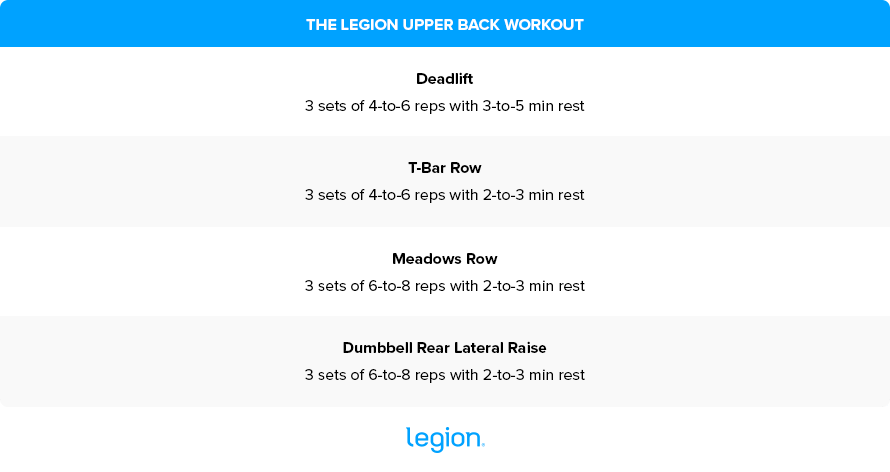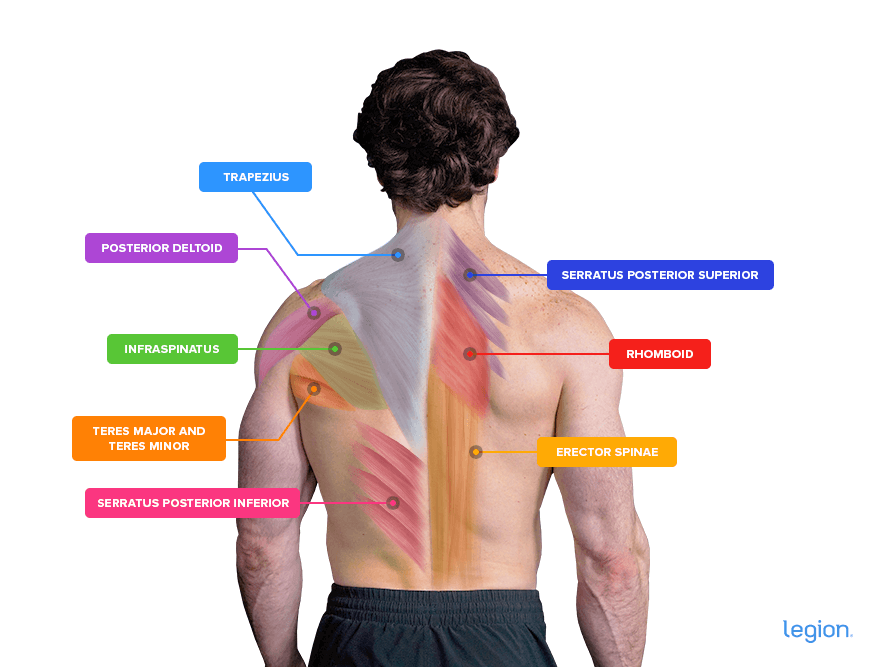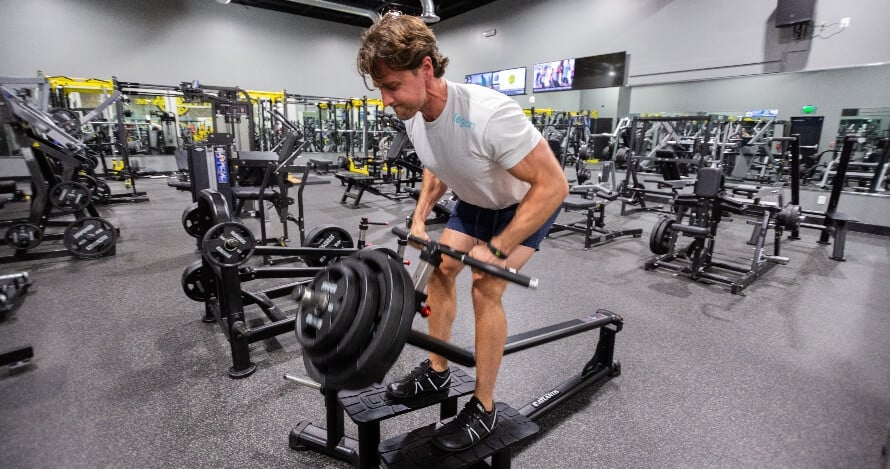If you’re serious about building an impressive physique, training your upper back should be a top priority.
A well-developed upper back not only enhances your upper body aesthetics and posture, it acts as the “scaffolding” that supports your torso, improving your performance on key exercises like the squat, bench press, and deadlift.
And as a general rule, those who can squat, press, and pull the heaviest weights are usually the most jacked.
Despite this, many weightlifters struggle to build upper back mass because they rely on the same stagnant exercises that don’t effectively train these muscles. To make real progress, you need a new approach.
In this article, you’ll discover the most effective upper back exercises for achieving your goals. In my experience, these are:
- Deadlift
- Romanian deadlift
- Rack pull
- Barbell row
- One-arm dumbbell row
- Cable row
- Chest-supported row
- Seal row
- Meadows row
- T-Bar row
- Dumbbell upright row
- Face pull
- Dumbbell rear delt raise
You’ll learn why these exercises work so well, how to perform them for maximum gains, and how to organize them into upper back workouts that deliver real results.
Key Takeaways
- A strong upper back enhances your physique, improves posture, and boosts performance on key exercises like the squat, bench press, and deadlift.
- The best upper back exercises include deadlifts, various rows (barbell, cable, and dumbbell), and rear delt isolation exercises.
- To create great upper back workouts, start with a deadlift variation, then perform 2-to-3 upper back rows, and finish with an isolation exercise that emphasizes your rear delts.
- For maximum growth, prioritize progressive overload and take most sets close to muscular failure.
Table of Contents
+
The 13 Best Upper Back Exercises

Here’s a list of 13 great upper back exercises for gaining mass and strength. For each, we’ll discuss why they are so effective and how to do them to maximize upper back growth.
1. Deadlift
Why: The deadlift is the best upper back exercise because it allows you to put massive tension on your traps, rhomboids, lats, rear delts, and teres muscles, which is key to building upper back mass and strength. That’s why every well-designed workout for the upper back should center around the deadlift.
How to:
- Position your feet slightly narrower than shoulder-width apart with your toes pointed slightly out.
- Move a loaded barbell over your midfoot so it’s about an inch from your shins.
- Take a deep breath into your belly, then place your hands on the bar just outside your shins with your palms facing you.
- Flatten your back and drive your body upward and slightly back by pushing through your heels until you’re standing upright.
- Reverse the movement and return to the starting position.
RELATED: The 12 Best Deadlift Variations for Building Muscle and Gaining Strength
2. Romanian Deadlift
Why: The Romanian deadlift is another excellent upper back exercise because it targets the same muscles as the conventional deadlift—traps, rhomboids, lats, and rear delts—without being as taxing. This makes it perfect for training your upper back more frequently without wearing you to a frazzle.
How to:
- Stand up straight holding a loaded barbell with a shoulder-width, overhand grip (palms facing your body).
- Flatten your back and lower the weights toward the floor in a straight line while keeping your legs mostly straight, allowing your butt to move backward as you descend.
- Once you feel a stretch in your hamstrings, bend your knees slightly more and continue lowering the weights until your lower back begins to round.
- Reverse the movement and return to the starting position.
3. Rack Pull
Why: The rack pull trains your upper back muscles like the deadlift, but its shorter range of motion allows you to lift even heavier weights. This makes it ideal for maximizing upper back strength and muscle gain, which is why it’s a must-have in any great upper back workout.
How to:
- Place a loaded barbell on a squat rack’s safety arms at knee height or slightly lower.
- Position the midfoot of both feet under the barbell slightly narrower than shoulder-width apart with your toes pointed slightly out.
- Bend over and grab the bar with an overhand grip just outside your shins.
- Flatten your back and drive your body upward and slightly back by pushing through your heels until you’re standing up straight.
- Reverse the movement and return to the starting position.
4. Barbell Row
Why: Research shows that the barbell row is one of the very best upper back rowing exercises for training your lats, traps, and infraspinatus, while also engaging your mid and lower back. One of its biggest advantages is that it allows you to lift heavier weights than most upper back rows, making it perfect for overloading and building strength throughout the entire back.
How to:
- Position your feet shoulder-width apart under a loaded barbell with your toes pointed slightly outward.
- Bend over and grab the bar with a slightly wider than shoulder-width grip and your palms facing you.
- Straighten your back and raise your hips until your back is roughly parallel to the floor.
- Driving through your legs, then, using the momentum generated by your lower body, squeeze your shoulder blades together and pull the bar to your upper body, touching it anywhere between your lower chest and belly button.
- Reverse the movement and return it to the starting position.
RELATED: Lat-Focused Workouts: The 11 Best Lat Exercises for Muscular Lats
5. One-Arm Dumbbell Row
Why: The one-arm dumbbell row targets your mid and upper back one side at a time, making it one of the best exercises for identifying and correcting muscle and strength imbalances. If you do dumbbell upper back workouts, the one-arm dumbbell row should be a permanent fixture.
How to:
- Hold a dumbbell in your right hand.
- Plant your left knee and hand firmly on a bench, your right foot on the floor a foot or two from the bench, and let your right arm hang straight toward the floor.
- Keeping your back straight, pull the dumbbell upward until it touches your torso, then return it to the starting position.
- Once you’ve completed the desired number of reps, repeat the process with your left arm.
RELATED: Unilateral vs. Bilateral Exercises: Which Is Better for Muscle Building and Performance?
6. Cable Row
Why: Upper back exercises with cables, like the cable row, keep constant tension on your muscles throughout each rep, which offers a different challenge compared to free weights. This adds variety and intensity to your upper back workouts, which likely aids growth.
How to:
- Sit on the cable row machine and place your feet on the footrest while maintaining slightly bent knees.
- Lean forward and grab the handle, then lean back with your arms stretched in front of you.
- Straighten your back and pull the handle toward your stomach.
- Once your hands touch your torso, reverse the movement and return to the starting position.
RELATED: The Best Cable Back Workouts and Exercises for a Wide Back
7. Chest-Supported Row
Why: The chest-supported row is a top-tier dumbbell exercise for your upper back because it prevents you from using momentum to “cheat” the weight up, forcing your upper back muscles to do the majority of the work without relying on other body parts to assist.
How to:
- Set an incline bench to roughly a 30-degree angle.
- Grab a dumbbell in each hand and lie prone on the bench with your feet on the floor and your arms extended toward the ground.
- Pull the dumbbells upward until they’re by your sides.
- Reverse the movement and return to the starting position.
8. Seal Row
Why: The seal row has you lie facedown on a bench, which prevents you from using your lower body to help lift the weight. As a result, your traps, rhomboids, and other upper back muscles have to work harder which ensures they’re maximally stimulated.
How to:
- Place a loaded barbell under a seal row bench, then lie prone on the bench.
- Grab the bar with a slightly wider than shoulder-width grip and your palms facing your feet.
- Pull the bar toward your upper body until it touches the underside of the bench.
- Extend your arms and return to the starting position.
9. Meadows Row
Why: For the Meadows row, you anchor the barbell at one end and pull it through an arcing range of motion. As such, it trains your upper back muscles differently than other exercises, which likely benefits size and strength gain.
How to:
- Wedge one end of a barbell into the corner of the room or insert it into a landmine attachment and load the other end with weight.
- Position your right foot perpendicular to the weighted end of the barbell and your left foot 2-to-3 feet behind your right.
- Bend over at the waist until your back is almost parallel with the floor, and grab the end of the barbell with your left hand.
- Pull the bar until your hand touches your torso, then lower it to the starting position.
- Once you’ve completed the desired number of reps, repeat on your right side.
RELATED: The Best Landmine Exercises for Whole-Body Mass and Strength
10. T-Bar Row
Why: Like all good upper back exercises, the T-bar row lets you lift heavy weights safely. What sets it apart is its neutral grip, which trains shoulder extension (bringing your arms to your sides from in front of you) rather than shoulder transverse abduction (moving your upper arms out to the sides) like most other upper back rows. This adds valuable variety to your upper back workouts, which promotes more balanced muscle growth.
How to:
- Stand on the T-bar row machine’s footplate facing the weighted end of the bar and with the barbell between your legs.
- While keeping your back flat and knees slightly bent, “hinge” forward until your upper body is at a 30-to-45-degree angle relative to the floor.
- Grab the handle with a neutral grip and lift the bar off the rest.
- Pull the handle toward your body until it touches your torso.
- Reverse the movement and return to the starting position.
11. Dumbbell Upright Row
Why: The dumbbell upright row is a fantastic dumbbell exercise for your upper back and shoulders. While the barbell and cable versions are viable variations, the dumbbell version allows you to move your arms and shoulders more freely, which helps you avoid any discomfort you may feel when your hands are more fixed.
How to:
- Stand upright with a dumbbell in each hand, arms straight and palms facing your thighs.
- Lift the dumbbells straight upward until your upper arms are parallel with the floor, keeping your elbows higher than your forearms throughout the movement.
- Reverse the movement and return to the starting position.
12. Face Pull
Why: Face pulls strengthen the shoulder and upper back muscles responsible for pulling horizontally and rotating your arm upward, which is difficult to do with any other exercise and may improve shoulder health. In other words, the face pull is a great upper back exercise for keeping your shoulders healthy and preventing upper back pain. While cable face pulls are a popular choice, the resistance band version is a convenient alternative that adds variety to your routine.
How to:
- Wrap a resistance band around a sturdy post at shoulder height.
- Hold one end of the band in each hand and walk backward until the slack is out of the band and your arms are straight
- Place your feet shoulder-width apart and slightly bend your knees.
- While keeping your elbows up, pull the band toward your eyes allowing your palms to rotate outward and your hands to move apart until they’re above your shoulders.
- Reverse the movement and return to the starting position.
13. Dumbbell Rear Lateral Raise
Why: The rear lateral raise is another great dumbbell upper back exercise to include in your routine because it emphasizes the rear delts, the small muscles on the backs of your shoulders that often need a little extra volume to keep up with the rest of your upper back muscles. In other words, it ensures you build a balanced, proportional upper back.
How to:
- Whether standing or seated, bend at the hips so that your upper body is as close to parallel to the floor as possible.
- Hold a dumbbell in each hand, and while keeping your back flat, lift the dumbbells out to the side until your upper arm is parallel to the floor. As you lift the dumbbells, squeeze your shoulder blades together.
- Reverse the movement and return to the starting position.
RELATED: The 12 Best Rear Delt Exercises for Mass and Hypertrophy
The Best Upper Back Workout for Mass & Strength

You now know the best upper back exercises for building mass and strength, so let’s look at how to organize them into an effective workout.
A great upper back workout should include:
- A Deadlift Variation: Deadlifts train all your upper back muscles with heavy weights, making them perfect for gaining mass and strength. Starting your routine with a deadlift is sensible, as it demands the most effort, so it’s best to do it when you’re fresh.
- Upper Back Rowing Exercises: Choose 2-to-3 upper back rows that train your muscles from different angles. Mix grip orientations (overhand, underhand, neutral), and include both bilateral movements (working both sides of your body at once) and unilateral movements (working one side at a time) to ensure you build balanced back mass.
- A Rear Delt Isolation Exercise: Finish with a rear delt isolation exercise to stimulate all areas of your upper back without overdoing it with heavy compound exercises.
Below is a routine that hits all these marks perfectly. Do it once weekly for 8-to-10 weeks, and watch your upper back grow.

The Benefits of Training Your Upper Back
Improved Posture
Many people with poor posture have weak upper back muscles. Strengthening them with effective upper back exercises helps you to pull your shoulder blades together and prevents excessive upper back rounding.
Balanced Size and Strength Gain
Many beginner weightlifters focus on training the upper body muscles that are visible from the front but neglect their back.
The consequence is that they build an imbalanced physique, with well-developed “mirror muscles” that overshadow their underdeveloped back.
Doing upper back workouts helps your back muscles grow in size and strength at a similar rate to your chest, shoulders, and arms, ensuring your physique and performance stay balanced and strong.
RELATED: How to Find and Fix Muscle Imbalances
Enhanced Athletic Performance
A strong upper back is essential if you want to lift heavy weights—it prevents you from tipping forward in the squat, stops your spine from rounding in the deadlift, and creates a stable base during the bench press.
By using good upper back exercises to train your traps, rhomboids, rear delts, and other upper back muscles, you enhance your performance on these key lifts, helping you lift more weight and gain more full-body muscle and strength over time.
Anatomy of the Upper Back Muscles
Here are the main upper back muscles and their functions:

- Trapezius: Often called the “traps,” this large muscle spans from your neck to your mid-back and is crucial for moving and stabilizing the shoulder blades.
- Rhomboids: These muscles lie beneath the trapezius and connect the spine to the shoulder blades, aiding their movement. They also support your posture.
- Erector Spinae: The muscles running vertically alongside the spine. They’re vital for maintaining upright posture and rotating your torso.
- Teres Muscles: These comprise the teres major and minor. They’re located near the shoulder blades, and help rotate and move your arms toward your body’s centerline.
- Posterior Deltoids: Located on the shoulder’s backside, they help in moving the arm backward.
- Infraspinatus: The infraspinatus is part of the rotator cuff. It’s essential for shoulder stability.
- Accessory Muscles: Additional support muscles include the serratus posterior superior and serratus posterior inferior, which assist breathing by elevating and depressing the ribs, respectively.
3 Expert Tips for More Productive Upper Back Workouts

1. End every set 1-to-2 reps shy of muscle failure.
To maximize muscle and strength gains, you must take most of your sets within a rep or two of muscle failure.
Ask yourself at the end of each set, “If I had to, how many more reps could I have gotten with good form?” If the answer is more than two, increase the weight or reps to make your next set more challenging.
2. Once you hit the top of your rep range for one set, increase the weight.
If your upper back workout calls for 4-to-6 reps of the deadlift and you get 6 reps for a set, add 10 pounds to your next set.
If you manage 3 or fewer reps with the new weight, reduce the weight by 5 pounds to ensure you stay in the 4-to-6 rep range.
Follow this pattern of trying to add reps or weight to every exercise in every upper back workout.
3. Take the right supplements.
The best supplements for maximizing upper back development are:
- Protein powder: Protein powder provides your body with the nutrients needed to build muscle tissue and recover from your upper back workouts.
- Creatine: Creatine boosts muscle and strength gain, improves anaerobic endurance, and reduces muscle damage and soreness from your workouts. In other words, it helps you train harder and recover faster, which is vital for gaining upper back mass and strength.
- Pre-workout: A high-quality pre-workout enhances energy, mood, and focus, increases strength and endurance, and reduces fatigue—welcome benefits when performing big, upper back exercises like deadlifts.
(If you’d like even more specific advice about which supplements you should take to reach your health and fitness goals, take the Legion Supplement Finder Quiz, and in less than a minute, you’ll know exactly what supplements are right for you. Click here to check it out.)
FAQ #1: How can I thicken my upper back?
To thicken your upper back, follow these steps:
- Prioritize exercises that allow you to train with heavy weights and progressively overload your traps, rhomboids, and lats. Deadlifts, rows (barbell, dumbbell and cable), and rack pulls work best for this.
- End your upper back workouts with isolation exercises like rear delt lateral raises and face pulls to train all areas of the upper back with sufficient volume.
- Eat enough calories and protein to fuel muscle growth. For personalized advice, take the Legion Diet Quiz.
FAQ #2: What is the best upper back exercise?
The best upper back exercise is the deadlift. It allows you to lift the heaviest weights possible, which creates maximum tension in the traps, rhomboids, lats, and rear delts. This makes it ideal for building upper back mass and strength.
For best results, include variations like the Romanian deadlift and rack pull to train the muscles through different ranges of motion.
FAQ #3: What are the best upper back pain exercises?
The best exercises for alleviating upper back pain are face pulls, band pull-aparts, and cable rows, as these exercises strengthen and mobilize the muscles around the shoulder blades and spine.
Stretches that increase upper back mobility may also help alleviate tension and discomfort. For my favorite upper back stretches for alleviating pain, check out this article:
Is Flexibility Important for Being Fit?
Scientific References +
- Handa, Tohru , et al. Comparative Electromyographical Investigation of the Biceps Brachii, Latissimus Dorsi, and Trapezius Muscles during Five Pull Exercises. Apr. 2005, pp. 54(2):159-168, https://doi.org/10.7600/jspfsm.54.159.
- Costa, Bruna Daniella de Vasconcelos, et al. “Does Performing Different Resistance Exercises for the Same Muscle Group Induce Non-Homogeneous Hypertrophy?” International Journal of Sports Medicine, vol. 42, no. 09, 13 Jan. 2021, pp. 803–811, https://doi.org/10.1055/a-1308-3674.
- McAllister, Matthew J., et al. “Effect of Grip Width on Electromyographic Activity during the Upright Row.” The Journal of Strength & Conditioning Research, vol. 27, no. 1, 1 Jan. 2013, pp. 181–187, journals.lww.com/nsca-jscr/Fulltext/2013/01000/Effect_of_Grip_Width_on_Electromyographic_Activity.25.aspx, https://doi.org/10.1519/JSC.0b013e31824f23ad.
- Kolber, Morey J., et al. “Characteristics of Shoulder Impingement in the Recreational Weight-Training Population.” The Journal of Strength & Conditioning Research, vol. 28, no. 4, 1 Apr. 2014, pp. 1081–1089, journals.lww.com/nsca-jscr/FullText/2014/04000/Characteristics_of_Shoulder_Impingement_in_the.28.aspx, https://doi.org/10.1519/JSC.0000000000000250.
- Stokes, Tanner, et al. “Recent Perspectives Regarding the Role of Dietary Protein for the Promotion of Muscle Hypertrophy with Resistance Exercise Training.” Nutrients, vol. 10, no. 2, 7 Feb. 2018, p. 180, www.mdpi.com/2072-6643/10/2/180/pdf, https://doi.org/10.3390/nu10020180.
- Jd, Branch. “Effect of Creatine Supplementation on Body Composition and Performance: A Meta-Analysis.” International Journal of Sport Nutrition and Exercise Metabolism, 1 June 2003, pubmed.ncbi.nlm.nih.gov/12945830/.
- Eckerson, Joan M., et al. “Effect of Creatine Phosphate Supplementation on Anaerobic Working Capacity and Body Weight after Two and Six Days of Loading in Men and Women.” The Journal of Strength and Conditioning Research, vol. 19, no. 4, 2005, p. 756, https://doi.org/10.1519/r-16924.1.
- Bassit, Reinaldo Abunasser, et al. “Effect of Short-Term Creatine Supplementation on Markers of Skeletal Muscle Damage after Strenuous Contractile Activity.” European Journal of Applied Physiology, vol. 108, no. 5, 3 Dec. 2009, pp. 945–955, https://doi.org/10.1007/s00421-009-1305-1.
- Chicharro, Márcia, et al. “Relaxation to Relieve Muscle Tension to the Upper Trapezius Level in Young Adults.” Annals of Medicine, vol. 51, no. sup1, 29 Mar. 2019, pp. 215–215, https://doi.org/10.1080/07853890.2018.1560723.










